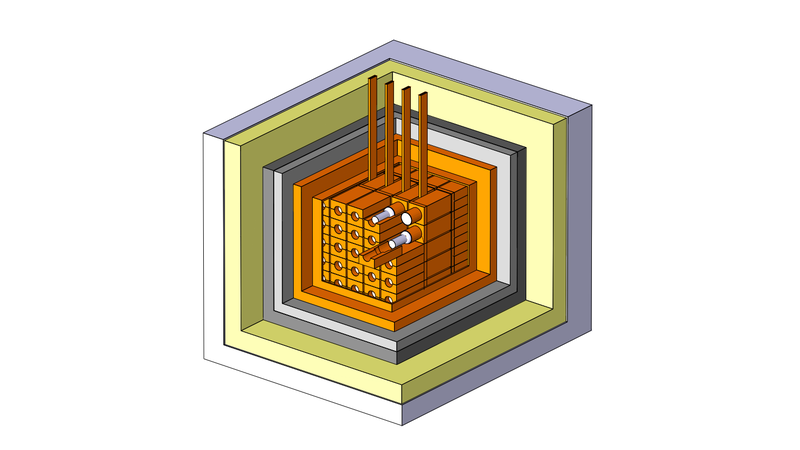This past June, 500 kilograms of a specially fabricated crystal buried in an Italian mountain seemed to glow just a little brighter. It wasn’t the first time, nor the last—every year, the signal seems to increase and decrease like clockwork as the Earth orbits the Sun.
Some people think the crystal has spotted a signature of elusive dark matter particles.
Scientists from an Italian experiment called DAMA/LIBRA announced at the XLIX meeting of the Gran Sasso Scientific Committee that after another six years observing, the annual modulation of their crystal’s signal is still present. This experiment was specially built to detect dark matter, and indeed, DAMA/LIBRA’s scientists are convinced they’ve spotted the elusive dark matter particle. Others are more skeptical.
“What we can say for sure is that they see a modulation over the period of the year,” Jonathan Davis, astroparticle physicist at King’s College London in the UK who was not involved in the study, told Gizmodo. “It peaks in early June, roughly where you’d expect the dark matter signal to peak as well,” based on the Earth’s velocity compared to where the dark matter would be coming from in the galaxy.
Continued observations of distant galaxies reveal that most of the universe’s calculated mass seems to be unaccounted for. The common explanation for this anomaly is dark matter, a theoretical substance that interacts with visible matter only through gravity, and perhaps very, very weakly through some other force.
Lots of incredibly sensitive experiments sit deep underground in wait of a passing dark matter particle. These include the liquid xenon-filled XENON1T in Italy, Particle and Astrophysical Xenon Detector (PandaX) in China, and LZ in South Dakota, as well as the Cryogenic Dark Matter Search semiconductor experiment in Minnesota. All of these hunt for the most likely dark matter candidate, a new subatomic particle that interacts very weakly with regular matter, called the WIMP.
DAMA/LIBRA uses a different kind of detector: sodium iodide crystals with extra thallium atoms inside that should emit a tiny flash if they are excited by a passing dark matter particle. They continue to see an annual modulation of an unexplained signal depending on how the Earth travels relative to the galaxy as a whole. Perhaps the planet is receiving more dark matter particles as it moves into, versus away from a presumed dark matter source.
DAMA/NaI and its sequel DAMA/LIBRA have now reported the modulation for two rounds observations spanning over a decade.
But there’s lots of causes for concern. Most importantly, no one else has been able to confirm the DAMA/LIBRA results. “We’re definitely doing this type of analysis as well to see an annual modulation,” Laura Baudis, physicist at the Physik Institut of the University of Zurich, told Gizmodo. “We haven’t seen it, others haven’t seen it.” Perhaps this is a special kind of dark matter that interacts differently with the sodium crystal than with liquid xenon—but theorists are having trouble coming up with what might cause such a difference. If DAMA/LIBRA really sees dark matter, they’re seeing something more exotic than commonly theorized.
Baudis and Davis both told Gizmodo that DAMA/LIBRA hasn’t been sharing their data with other physicists, which is unusual when so many other large physics experiments share their data. So it’s hard for outsiders to offer confirmation or verify that this isn’t just some mundane annual signal, perhaps from cosmic rays in the atmosphere or something related to the changing temperature of the Earth based on the seasons. On top of the secrecy, Davis said that DAMA LIBRA spokesperson Rita Bernabei has aggressively promoted the idea that DAMA/LIBRA has discovered a dark matter signal to the physics community. Bernabei thanked me for my interest when I asked for a comment, but has not yet addressed the other physicists’ concerns. I will update the post when I hear back.
The results have given others the incentive to look for the same signal, too, in the Southern and Northern Hemispheres, with the same sodium ion detectors, said Baudis, such as the SABRE collaboration. If SABRE spots the same signal in the same phase, in both hemispheres, it would strengthen DAMA/LIBRA’s case. But if the two hemisphere’s signals peak at different times during the year, perhaps there’s something less exotic going on, said Davis.
As is always the case with dark matter, hints like this are still tantalizing.
“It’s still something exciting,” said Baudis. “We’re trying to find out what it could be. No one knows at this point. It would be much easier if people had access to the data, but that’s not the case.”


 RSS Feed
RSS Feed
